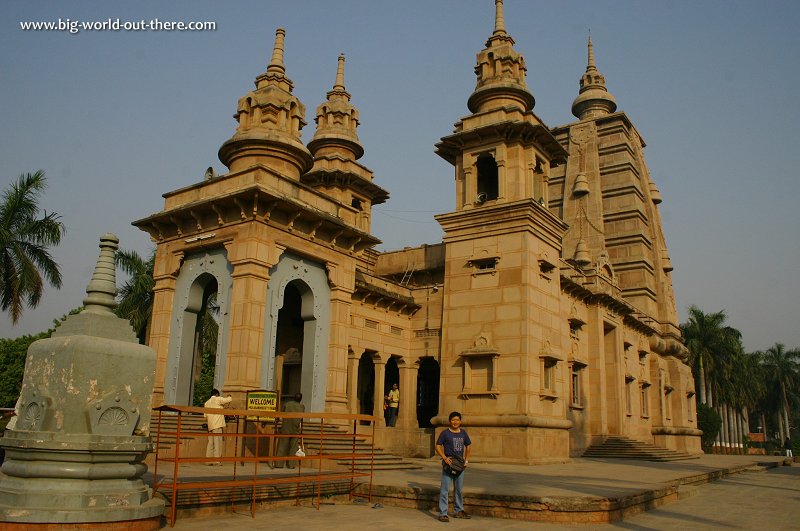 Mulagandha Kuty Vihara, Sarnath (16 November, 2004)
Mulagandha Kuty Vihara, Sarnath (16 November, 2004)
Sarnath Buddhist Pilgrimage Site is one of the most sacred pilgrimage sites of Buddhism in Uttar Pradesh, India. It is located just 10km from the city of Varanasi. Also called the Deer Park, Mrigadava, Rishipattana, and Isipatana, Sarnath was where Buddha delivered his first sermon to his five travel companions after attaining Enlightenment at Bodh Gaya, Bihar. This event is known in Buddhist literature as Dharm-Chakra-Pravartana, or "The Turning of the Wheel of Law". Before he died, Buddha named Sarnath as one of the four sacred places to Buddhism. The other three are Lumbini, Bodh Gaya and Kushinagar.
Map of Sarnath
Sarnath Tourist Attractions
According to belief, in Sarnath the Buddha encountered the five ascetics on his earlier austerities. On meeting the enlightened Buddha, all they saw was an ordinary man; they mocked his well-nourished appearance. "Here comes the mendicant Gautama," they said, "who has turned away from asceticism. He is certainly not worth of our respect." When they reminded him of his former vows, the Buddha replied, "Austerities only confuse the mind.
In the exhaustion and mental stupor to which they lead, one can no longer understand the ordinary things of life, still less the truth that lies beyond the senses. I have given up extremes of either luxury or asceticism. I have discovered the Middle Way". Hearing this the five ascetics became the Buddha's first disciples.
Gautama Buddha explained the middle way which avoids extremes, the Four Noble Truths, and prescribed the Eight-fold path. The Four Noble Truths are: 1. There is suffering; 2. Suffering has a cause; 3. The cause is removable, and 4. There are ways to remove the causes. So as to remove the causes the Buddha prescribed an Eight-fold Path: Right speech, Right action, Right livelihood, Right effort, Right mindfulness, Right concentration, Right attitude and Right view.
A Monastic tradition flourished for over 1,500 years on the site of the deer park at Sarnath. Emperor Ashoka, instumental in spreading Buddhism throughout his empire, visited Sarnath around 234 BC and erected a stupa there. He also erected a column 15.24 m in height which had four lions as its capital. The capital is now housed in the archaeology museum opposite the park. The lions on the pillar symbolise both Ashoka's imperial rule and the kingship of the Buddha. The Government of modern India adopted the four-lion capital of the Ashoka Column as its emblem. You can view it at the archaeology museum, opened daily except Friday, 10am-4.45pm.
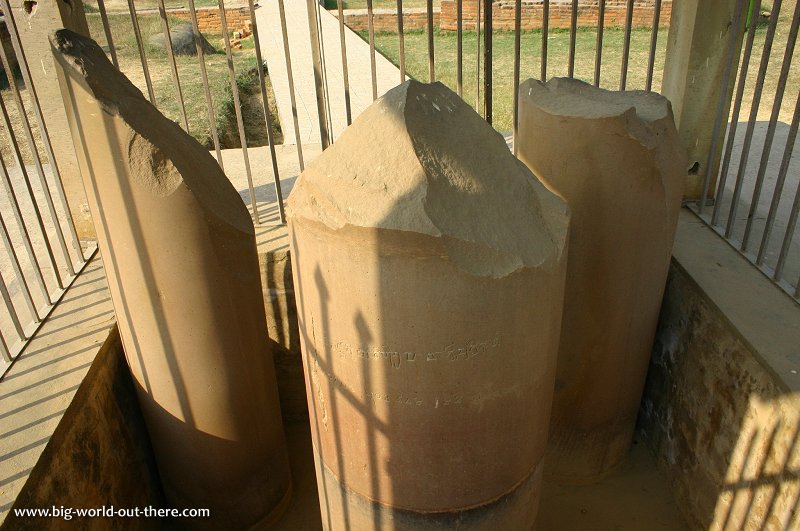 Ashoka Pillar in Pieces (17 November 2004)
Ashoka Pillar in Pieces (17 November 2004)
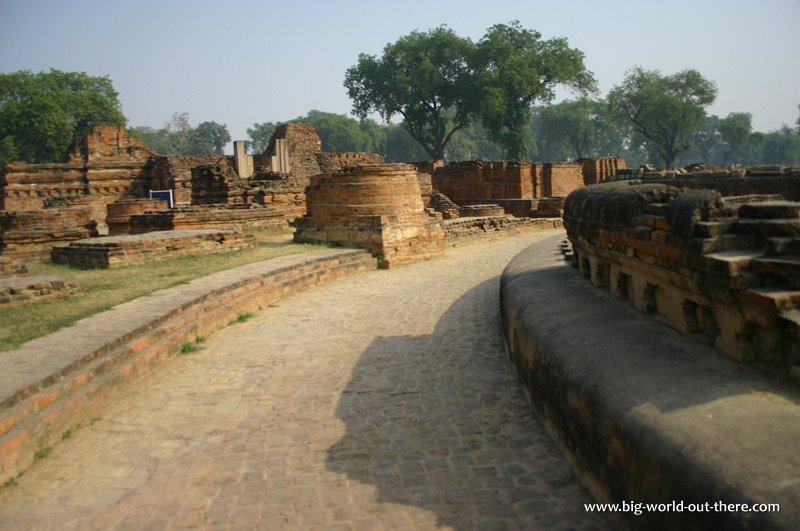 Archaeological site at Sarnath (17 November 2004)
Archaeological site at Sarnath (17 November 2004)
In 1194 AD, Kutubuddin Aibak, the Muslim conqueror, leveled the city to the ground. Sarnath became a forest of debris below which the historical ruins remained buried. Of the two great stupas which adorned the city only the Dhamek Stupa remained.
Many of the stupas in Sarnath were raised between the 3rd century BC and the 11th century AD. The last and largest monastery constructed before the Muslim invasion was Dharma-Chakar-Jina Vihar, erected by Kumardevi, wife of King Govinda Chandra, who ruled over Varanasi from 1114 to 1154. The Dhamek Stupa is said to mark the exact spot where Buddha preached.
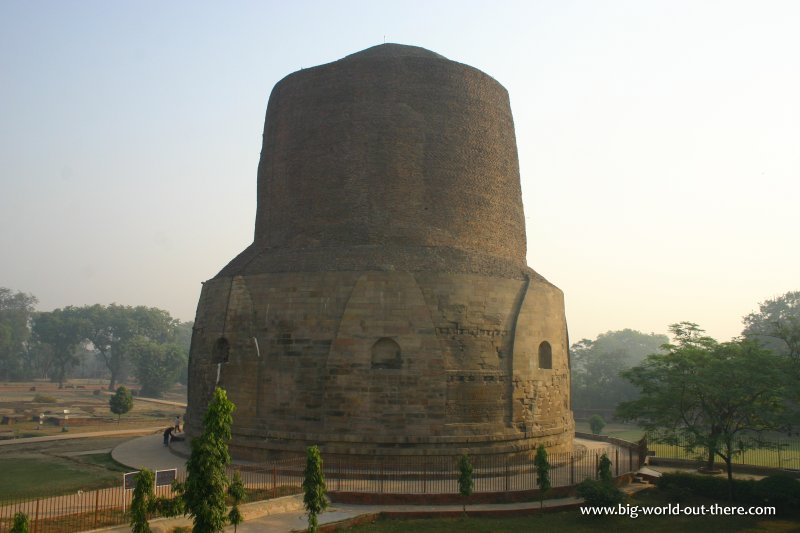 Dhamekh Stupa, the most prominent monument at the Sarnath Archaeological Site (16 November 2004)
Dhamekh Stupa, the most prominent monument at the Sarnath Archaeological Site (16 November 2004)
The archaeological importance of Sarnath was first brought to light by two archaeologists, Mr Duncan and Colonel Mackenzie in 1798. This was followed by a series of excavations by Colonel Alexander Cunningham (1835-36), Major Kittoe (1851-52), Mr F.O. Oertel (1904-05), Sir John Marshall (1907), M.H. Hargreaves (1914-15) and finally by Dayaram Sahani. These excavations uncovered a number of ancient monasteris, stupas, temples, inscriptions, sculptures and other antiquities from the 3rd century BC to the 12th century AD. Noteworthy among these ruins excavated are the Chaukhandi Stupa, Dharmrajka Stupa, Dhamekh Stupa, Mulgandha Kuti, an Ashokan Pillar and the Lion Capital.
I had the opportunity to visit Sarnath as an excursion from Varanasi, when I explored India with a group of AsiaExplorers members. My friends and I hired a tut-tut (three-wheel motor taxi) to take us around for the morning part of the day. It was a rather unpleasant experience in the end, because we were once again being fleeced by the driver, who wanted to charge us exorbitantly by the hour. For the reason, he took us through many detours and unscheduled stops until we were quite fed up and stopped and tut-tut and marched off, paying him the initially agreed amount.
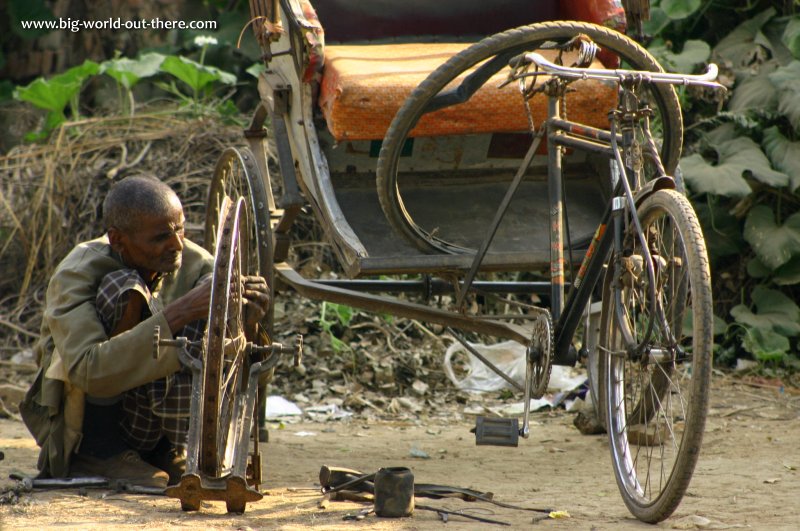 An old man repairing the wheel of his rickshaw in Sarnath (16 November, 2004)
An old man repairing the wheel of his rickshaw in Sarnath (16 November, 2004)
Getting there
Sarnath is located 13 km northeast of Varanasi. You can get an auto rickshaw from Varanasi to take you there. Negotiate and agree on a price before you board. Be aware that the auto-rickshaws will take every opportunity to earn as much from you as possible, including taking you for sightseeing in other places apart from Sarnath. Be firm in what you want.Buddhist Pilgrimage Sites
Sarnath is one of the four major Buddhist pilgrimage sites in the world. The other three are Bodhgaya, Lumbini and Kushinagar. Latest updates on Penang Travel Tips
Latest updates on Penang Travel Tips
 Discover with Timothy YouTube Channel
Discover with Timothy YouTube Channel
 PG Food Channel
PG Food Channel
 Learn Penang Hokkien YouTube Channel
Learn Penang Hokkien YouTube Channel
 SojiMart Videos
SojiMart Videos
 Share your travels and/or ask a travel-related question
Share your travels and/or ask a travel-related question
Join the Penang Travel Tips Facebook Group to share photos, tips and anything related to your travels, or ask travel-related questions.
 Map of Roads in Penang
Map of Roads in Penang
Looking for information on Penang? Use this Map of Roads in Penang to zoom in on information about Penang, brought to you road by road. Discover with Timothy
Discover with Timothy
Let me take you to explore and discover Penang through my series of walking tours on YouTube. You may use these videos as your virtual tour guide. At the beginning of each video, I provide the starting point coordinates which you may key into your GPS, Google Maps or Waze, to be navigated to where I start the walk, and use the video as your virtual tour guide.Disclaimer
Please use the information on this page as guidance only. The author endeavours to update the information on this page from time to time, but regrets any inaccuracies if there be any.Latest from Discover with Timothy: Gurney Bay - what to see and do there
About this website

Hello and thanks for reading this page. My name is Timothy and my hobby is in describing places so that I can share the information with the general public. My website has become the go to site for a lot of people including students, teachers, journalists, etc. whenever they seek information on places, particularly those in Malaysia and Singapore. I have been doing this since 5 January 2003, for over twenty years already. You can read about me at Discover Timothy. By now I have compiled information on thousands of places, mostly in Peninsular Malaysia and Singapore, and I continue to add more almost every day. My goal is to describe every street in every town in Malaysia and Singapore.
Robbie's Roadmap
- Episode 1: Robbie's Journey to Financial Freedom
- Episode 2: Lost in America
- Episode 3: The Value of Money
- Episode 4: The Mentor
- Episode 5: The Thing that Makes Money
- Episode 6: The walk with a Billionaire
- Episode 7: The Financial Freedom Awakening
- Episode 8: Meet Mr Washington
- Episode 9: The Pizzeria Incident
Copyright © 2003-2024 Timothy Tye. All Rights Reserved.


 Go Back
Go Back







